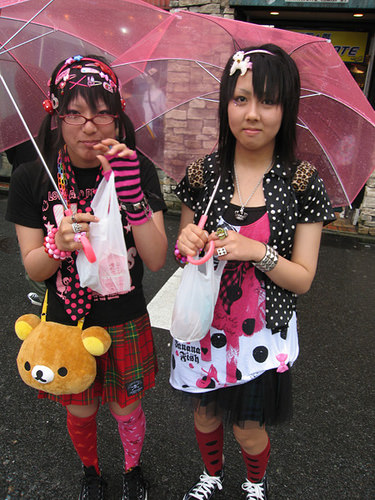
LITTLE PIM BLOG
5 DIY Halloween Costumes with Global Appeal
Looking for some inspiration for your family's Halloween costumes this year? Pull out the globe and give it a spin. With a little inspiration from our great DIY globally-inspired options below, and a few accessories, your kids’ costumes will be United Nations worthy in no time.
1. Harajuku Girls, Japan -- Here’ an opportunity to open up the costume chest and go wild. Fun-loving Harajuku girls are known for their creative style of dress and love of all things kitsch --- to channel their irrepressible style into a unique Halloween costume, think layers: Start with striped knee socks, layered crinoline skirts, and a Hello Kitty tee or the like. Then add HIGH pigtails tied with bows and layer on the plastic accessories. Add some glittery makeup and you’re ready to rock the trick-or-treat block.
2. Gondolier, Italy – This is an easy and memorable costume. To start, your little gondolier will need a striped shirt and black pants, plus a round-rimmed hat (party stores often have inexpensive Styrofoam versions). Take a trip to the trim department of the craft store for thick red ribbon (about 6 inches across) for a waist sash and a thinner red ribbon to tie around the base of the hat. Then add a broom, small oar, or even a long dowel to stand in for an oar. Extra points for crooning “Amore”.
3. Frida Kahlo, Mexico – The beloved Mexican artist had a unique look that’s easy and fun to recreate. Pick up a felt mustache at the party store and stick between the eyebrows (conversely, use an eyebrow pencil to create a uni-brow). Tuck brightly colored silk, paper, or plastic flowers in a wreath around the hair. Add a fringed shawl around the shoulders and wear a peasant skirt and brightly colored shirt. Palette optional.
4. Ninja, Japan – A comfy, easy, and easily recognizable costume for boys or girls. Start with black pajamas, black sweats, karate gear, or a black fitted tee and soft pants. Take a plain black head scarf and wrap tightly around the head and covering the brows, and then another around the mouth and chin. At the craft store, purchase red masking tape and the use it to create a criss-cross pattern on lower legs and arms. Add a red sash, and you’re ready to stealthily sneak down the block.
5.French chef– Start with largest white chef hat you can find (party stores sell inexpensive paper ones you can personalize with glitter and markers to say FRANCE or the fine cuisine destination of your choice). A white chef’s coat would be perfect here, but you can improvise with a white karate top, or even long sleeve white tee and a large white apron. Tie a red kerchief tied around the neck, the use plastic measuring cups or spoons or plastic food to accessorize. Bon appetit!
Halloween food around the world
For most American families, Halloween "treats" mean one thing: candy – mounds of bite-size morsels heaped into kids' bags in exchange for that magic phrase: "Trick or treat!" Other cultures, however, celebrate All Souls' Day, All Saints Day or Dia de Los Muertos (Nov. 1 and 2), from which our Halloween (All Hallows Eve) is derived, with different sorts of treats. Why not expand your family's cultural horizons this Halloween by trying some of these traditional sweet treats from around the globe?
Here are a few ideas about food from Halloween around the world - about what people eat in other countries, and recipes to go with them.
Soul cakes (England and Ireland): These sweet, round cakes were traditionally given out in England and Ireland on All Saints Day or All Souls' Day during the Middle Ages to those who went door-to-door saying prayers for the dead in what may be the forerunner to today's trick-or-treating. They can be made with raisins and currents and aromatic spices like allspice, nutmeg, cinnamon and ginger. (Soul cake recipe)
Fave dei morti (Italy): In Italy, All Souls' Day may be celebrated with delicate cookies (sometimes white, brown or pink) – made with almonds and covered with sugar – called Fave dei Morti or Ossei dei Morti, whose name translates to "Beans of the Dead" or "Bones of the Dead." (Fave dei morti recipe; Ossi dei Morti recipe)
Pan de Muerto (Mexico): This soft sweet bread is a Dia de Los Muertos (Day of the Dead) tradition in Mexico, sometimes eaten at the grave of a loved one or placed on an altar. It may be flavored with orange zest or decorated with a teardrop or bones, perhaps placed in a circle to represent the cycle of life. Some people even mold the bread into animals, angels or other evocative shapes. (Pan de Muerto recipe)
Guagua de pan (Ecuador): These "bread babies" – sweet rolls molded and decorated to look like small children or infants – are part of the Day of the Dead tradition in parts of South America. Often made of wheat and sometimes filled with sweet jelly, they may be exchanged as gifts between families and friends or used ceremonially. (Guagua de pan recipe)
So what are you waiting for? Put down those miniature chocolate bars and start baking. These tasty treats will not only satisfy your sweet tooth, but your appetite for cultural exploration as well.






